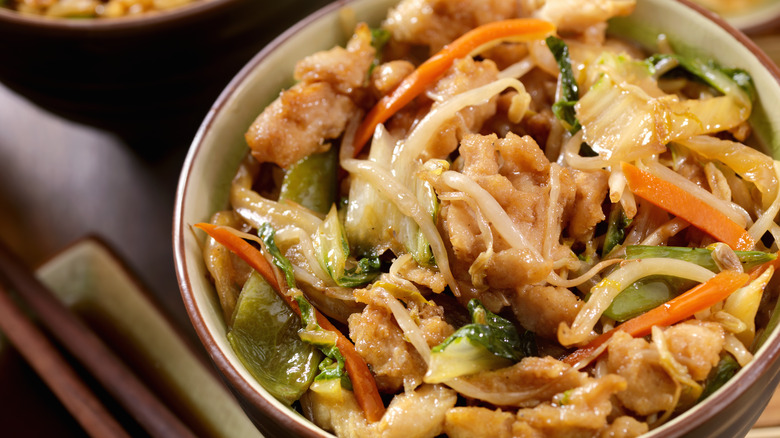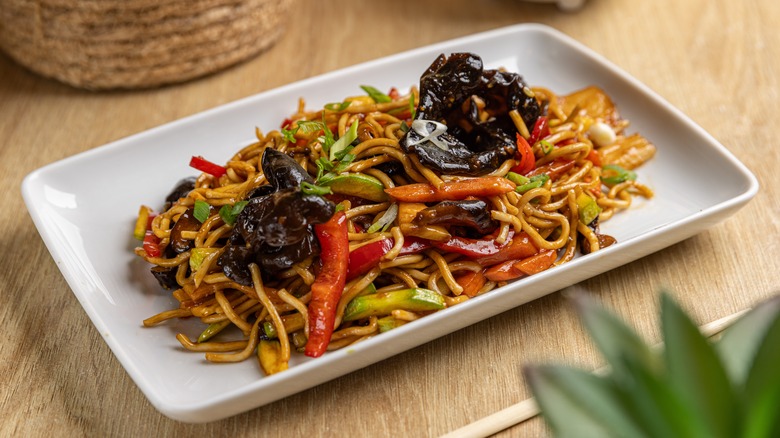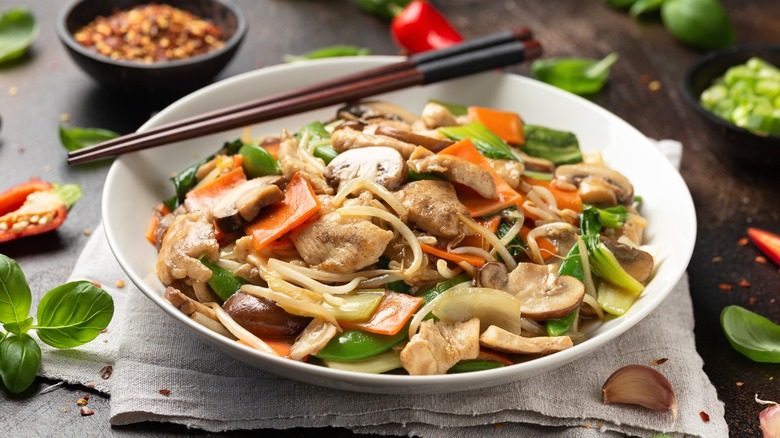Chop Suey Vs Chow Mein: How Do They Differ?
Chinese food restaurants are ubiquitous in the United States. From takeout-style beef and broccoli to moo goo gai pan, the history of how Asian cuisine became so popular in America is fascinating. So too, are the differences between some of the recipes. Take, for example, chow mein and chop suey — many people are familiar with and enjoy eating them, but might not know what differences make each dish unique.
While they are comparable since both are made with vegetables and distinctly Chinese sauces, the way they are prepared, their ingredients, and their origin stories are quite different. True, they both start off as stir-fries, but that's where their similarities end.
Chow mein is a Chinese noodle dish. It starts with chopped vegetables (and sometimes meat), which are stir-fried in a thin soy-based sauce. Parboiled noodles are added to the mix when the vegetables are nearly cooked through to coat them with sauce and complete their cooking. As for chop suey, it is also made with vegetables and meat but usually does not include noodles. The ingredients are fried up in a wok and coated in a thick gravy-style sauce, which is then served over rice. While both have standards for how they are made, they are also great for using up whatever leftover veggies or proteins are available.
Chow mein from coast to coast
How chow mein is prepared depends on geography. The dish is very popular in India, where it is referred to as hakka noodles, named for the unleavened wheat noodles that are used, along with fresh vegetables like carrots, cabbage, bell pepper, long beans, and spring onions. In the U.S., the way chow mein noodles are cooked is often the biggest variation, with the noodles usually made of egg dough, and there is a big difference between West and East Coast versions.
On the East Coast, the noodles are usually served crispy — also known as Hong Kong style — due to how they are deep-fried on the Chinese island. Over on the West Coast, chow mein noodles are more likely to be soft and springy, a dichotomy that often confuses people as to how chow mein is different from lo mein.
Chow mein was brought to America in the 19th century at the start of California's gold rush. The influx of Chinese immigrants brought their cuisine with them and used local ingredients to recreate their ancient recipes. The original dish that modern chow mein is based on goes back thousands of years to the Han dynasty, and its Cantonese name comes from the Taishan language: "chau," meaning stir-fry, and "meing" or "mian," referring to noodles. Adapted to American tastes, the dish as we know it today is regularly made with ingredients like celery, cabbage, green onions, bean sprouts, mushrooms, water chestnuts, and optionally, beef or chicken.
Chop suey's journey from China to Chinatown
Chop suey is generally thought of as a Chinese-American invention. Chinese restaurants sprang up around early mining towns, especially in San Francisco, where many migrating from China first landed. There are many myths about chop suey's American origins, but most have been debunked as folklore, and the dish is now believed to have Chinese origins.
According to one legend from 1849, some rowdy and hungry miners went to a Chinese restaurant at closing time, demanding to be fed. The chef didn't have any food left to prepare, so he threw together what remained from the previous customers' leftovers, zhuzhed it up with some sauce, and served his volatile guests their meal ... which they thoroughly enjoyed. Another story involving a Chinese diplomat named Li Hongzhang tells the tale of a banquet where he was unimpressed by the food, so he requested that his own chef make up something new for him from bits and pieces of what had been served.
Realistically, chop suey most likely came over from China with the same Cantonese immigrants who introduced chow mein to America. Its name has been roughly translated to mean "assorted mix," "odds and ends," "broken pieces," or "miscellaneous leftover," perhaps alluding to the pieces of offal that it was originally made with. At a typical Chinese restaurant today in the U.S., it is more common to have it made with pork, seafood, beef, or chicken.



